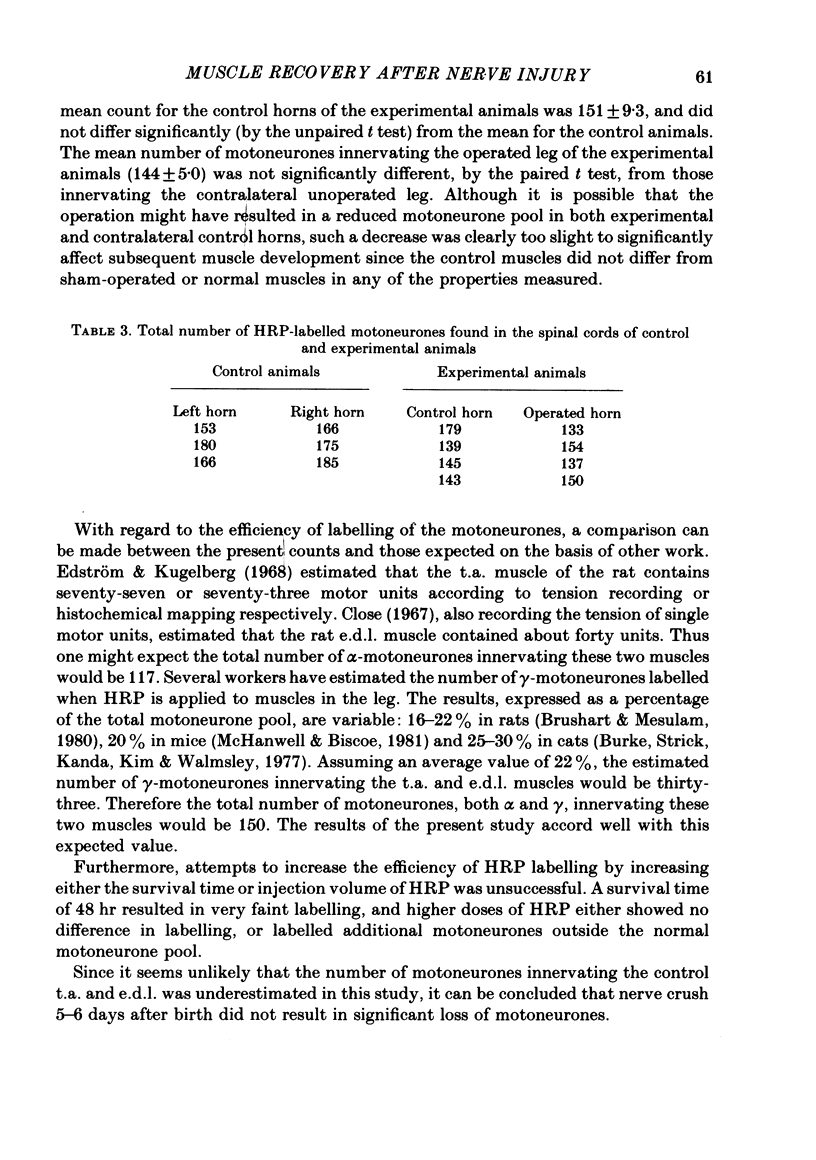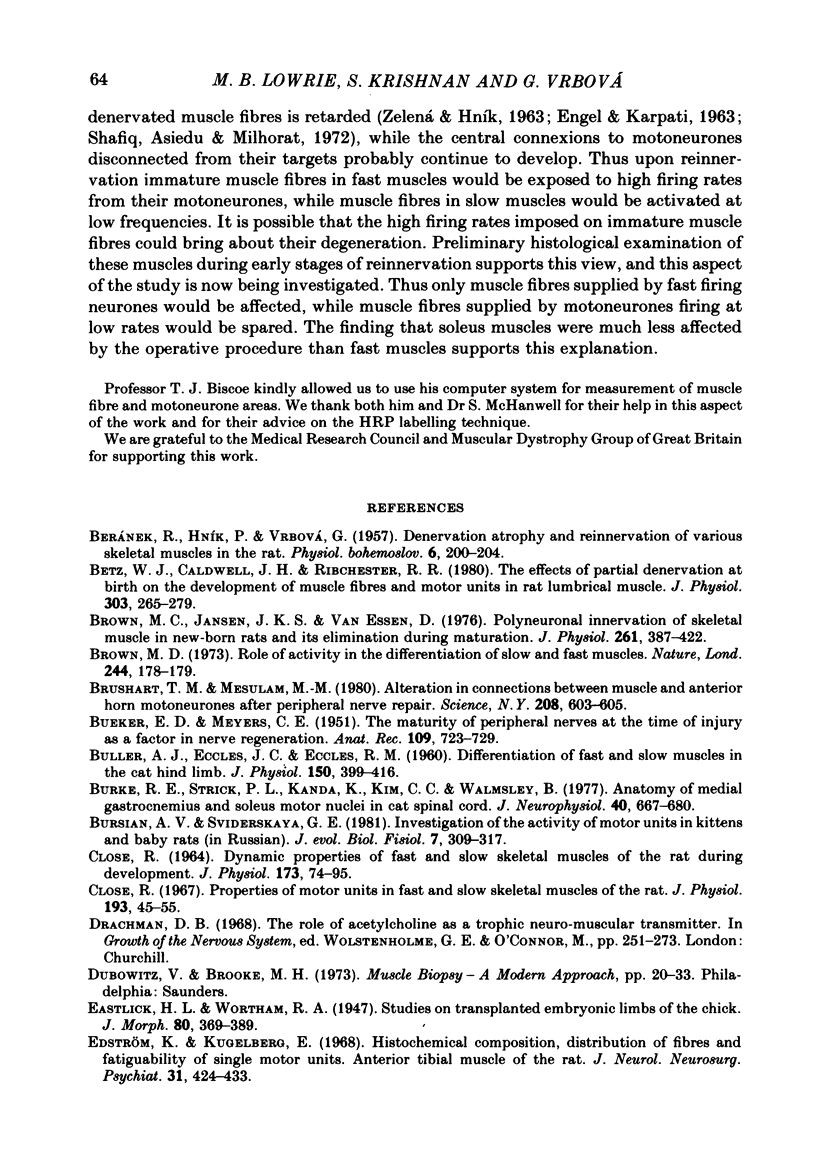Abstract
1. The sciatic nerve was crushed in 5-6-day-old rats and the recovery of function of slow and fast muscles was studied. The first signs of recovery of function were seen 10-12 days after the operation. 2. Maximal tetanic tension developed by the reinnervated muscles was recorded and taken as an indication of their recovery. Two months after nerve crush, slow soleus muscles developed only slightly less tension than the control unoperated soleus muscles. The reinnervated fast muscles tibialis anterior (t.a.) and extensor digitorum longus (e.d.l.) developed only about 50% of the tension of the unoperated controls. 3. The fast muscles never recovered, remaining weaker and smaller throughout the animals' life. 4. The number of muscle fibres in the reinnervated fast muscles was substantially reduced and their fibre composition altered in that they contained mainly muscle fibres with high levels of oxidative enzymes. 5. The reinnervated fast muscles became much more fatigue resistant than the unoperated controls. 6. The possibility that these changes are due to motoneurone death was examined. The motoneurones innervating the fast muscles were labelled by retrograde transport of HRP. No significant reduction in the number of motoneurones innervating the operated muscles was found. 7. These results show that nerve injury during early post-natal life causes permanent changes in fast muscles that are not caused by motoneurone death.
Full text
PDF


















Images in this article
Selected References
These references are in PubMed. This may not be the complete list of references from this article.
- BUEKER E. K., MEYERS C. E. The maturity of peripheral nerves at the time of injury as a factor in nerve regeneration. Anat Rec. 1951 Apr;109(4):723–743. doi: 10.1002/ar.1091090409. [DOI] [PubMed] [Google Scholar]
- BULLER A. J., ECCLES J. C., ECCLES R. M. Differentiation of fast and slow muscles in the cat hind limb. J Physiol. 1960 Feb;150:399–416. doi: 10.1113/jphysiol.1960.sp006394. [DOI] [PMC free article] [PubMed] [Google Scholar]
- Betz W. J., Caldwell J. H., Ribchester R. R. The effects of partial denervation at birth on the development of muscle fibres and motor units in rat lumbrical muscle. J Physiol. 1980 Jun;303:265–279. doi: 10.1113/jphysiol.1980.sp013284. [DOI] [PMC free article] [PubMed] [Google Scholar]
- Brown M. C., Jansen J. K., Van Essen D. Polyneuronal innervation of skeletal muscle in new-born rats and its elimination during maturation. J Physiol. 1976 Oct;261(2):387–422. doi: 10.1113/jphysiol.1976.sp011565. [DOI] [PMC free article] [PubMed] [Google Scholar]
- Brown M. D. Role of activity in the differentiation of slow and fast muscles. Nature. 1973 Jul 20;244(5412):178–179. doi: 10.1038/244178a0. [DOI] [PubMed] [Google Scholar]
- Brushart T. M., Mesulam M. M. Alteration in connections between muscle and anterior horn motoneurons after peripheral nerve repair. Science. 1980 May 9;208(4444):603–605. doi: 10.1126/science.7367884. [DOI] [PubMed] [Google Scholar]
- Burke R. E., Strick P. L., Kanda K., Kim C. C., Walmsley B. Anatomy of medial gastrocnemius and soleus motor nuclei in cat spinal cord. J Neurophysiol. 1977 May;40(3):667–680. doi: 10.1152/jn.1977.40.3.667. [DOI] [PubMed] [Google Scholar]
- CLOSE R. DYNAMIC PROPERTIES OF FAST AND SLOW SKELETAL MUSCLES OF THE RAT DURING DEVELOPMENT. J Physiol. 1964 Sep;173:74–95. doi: 10.1113/jphysiol.1964.sp007444. [DOI] [PMC free article] [PubMed] [Google Scholar]
- Close R. Properties of motor units in fast and slow skeletal muscles of the rat. J Physiol. 1967 Nov;193(1):45–55. doi: 10.1113/jphysiol.1967.sp008342. [DOI] [PMC free article] [PubMed] [Google Scholar]
- Edström L., Kugelberg E. Histochemical composition, distribution of fibres and fatiguability of single motor units. Anterior tibial muscle of the rat. J Neurol Neurosurg Psychiatry. 1968 Oct;31(5):424–433. doi: 10.1136/jnnp.31.5.424. [DOI] [PMC free article] [PubMed] [Google Scholar]
- Engel W. K., Karpati G. Impaired skeletal muscle maturation following neonatal neurectomy. Dev Biol. 1968 Jun;17(6):713–723. doi: 10.1016/0012-1606(68)90015-8. [DOI] [PubMed] [Google Scholar]
- Gordon T., Perry R., Tuffery A. R., Vrbová G G G. Possible mechanisms determining synapse formation in developing skeletal muscles of the chick. Cell Tissue Res. 1974;155(1):13–25. doi: 10.1007/BF00220281. [DOI] [PubMed] [Google Scholar]
- Gutmann E., Young J. Z. The re-innervation of muscle after various periods of atrophy. J Anat. 1944 Jan;78(Pt 1-2):15–43. [PMC free article] [PubMed] [Google Scholar]
- Hanker J. S., Yates P. E., Metz C. B., Rustioni A. A new specific, sensitive and non-carcinogenic reagent for the demonstration of horseradish peroxidase. Histochem J. 1977 Nov;9(6):789–792. doi: 10.1007/BF01003075. [DOI] [PubMed] [Google Scholar]
- Kelly A. M. Satellite cells and myofiber growth in the rat soleus and extensor digitorum longus muscles. Dev Biol. 1978 Jul;65(1):1–10. doi: 10.1016/0012-1606(78)90174-4. [DOI] [PubMed] [Google Scholar]
- Lieberman A. R. The axon reaction: a review of the principal features of perikaryal responses to axon injury. Int Rev Neurobiol. 1971;14:49–124. doi: 10.1016/s0074-7742(08)60183-x. [DOI] [PubMed] [Google Scholar]
- McArdle J. J., Sansone F. M. Re-innervation of fast and slow twitch muscle following nerve crush at birth. J Physiol. 1977 Oct;271(3):567–586. doi: 10.1113/jphysiol.1977.sp012015. [DOI] [PMC free article] [PubMed] [Google Scholar]
- McHanwell S., Biscoe T. J. The localization of motoneurons supplying the hindlimb muscles of the mouse. Philos Trans R Soc Lond B Biol Sci. 1981 Aug 12;293(1069):477–508. doi: 10.1098/rstb.1981.0082. [DOI] [PubMed] [Google Scholar]
- NACHLAS M. M., TSOU K. C., DE SOUZA E., CHENG C. S., SELIGMAN A. M. Cytochemical demonstration of succinic dehydrogenase by the use of a new p-nitrophenyl substituted ditetrazole. J Histochem Cytochem. 1957 Jul;5(4):420–436. doi: 10.1177/5.4.420. [DOI] [PubMed] [Google Scholar]
- Pullen A. H. The distribution and relative sized of fibre types in the extensor digitorum longus and soleus muscles of the adult rat. J Anat. 1977 Apr;123(Pt 2):467–486. [PMC free article] [PubMed] [Google Scholar]
- Romanes G. J. Motor localization and the effects of nerve injury on the ventral horn cells of the spinal cord. J Anat. 1946 Jul;80(Pt 3):117–131. [PMC free article] [PubMed] [Google Scholar]
- Round J. M., Matthews Y., Jones D. A. A quick, simple and reliable histochemical method for ATPase in human muscle preparations. Histochem J. 1980 Nov;12(6):707–710. doi: 10.1007/BF01012026. [DOI] [PubMed] [Google Scholar]
- Shafiq S. A., Asiedu S. A., Milhorat A. T. Effect of neonatal neurectomy on differentiation of fiber types in rat skeletal muscle. Exp Neurol. 1972 Jun;35(3):529–540. doi: 10.1016/0014-4886(72)90123-9. [DOI] [PubMed] [Google Scholar]
- Srihari T., Vrbová G. The role of muscle activity in the differentiation of neuromuscular junctions in slow and fast chick muscles. J Neurocytol. 1978 Oct;7(5):529–540. doi: 10.1007/BF01260887. [DOI] [PubMed] [Google Scholar]
- Stewart D. M. Effect of age on the response of four muscles of the rat to denervation. Am J Physiol. 1968 May;214(5):1139–1146. doi: 10.1152/ajplegacy.1968.214.5.1139. [DOI] [PubMed] [Google Scholar]





